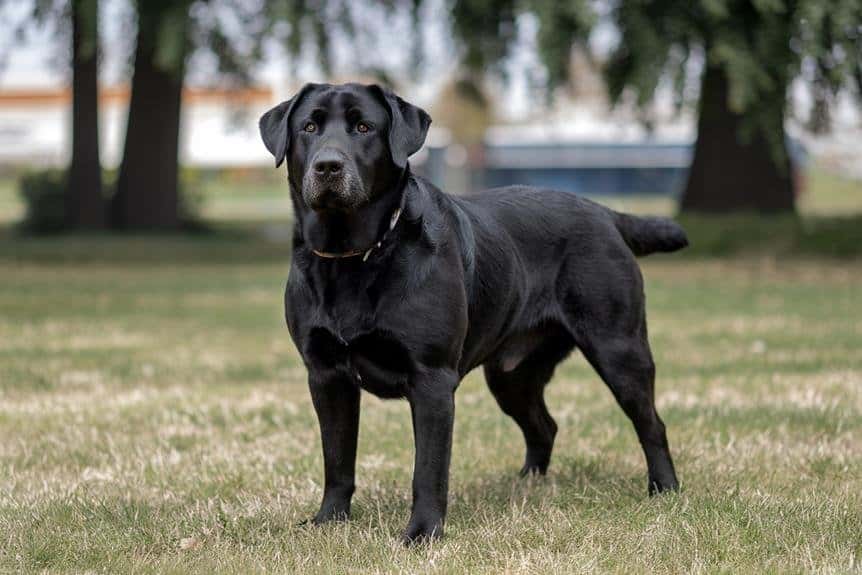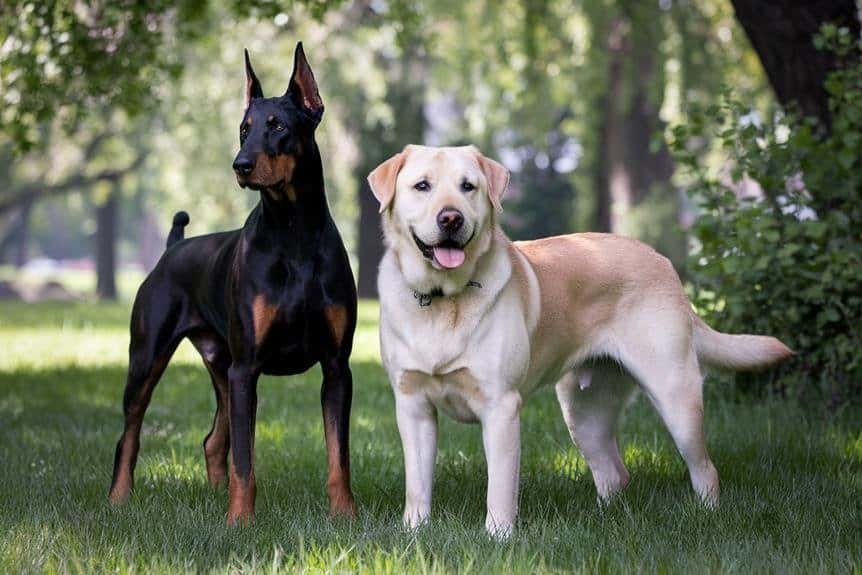If you’re considering adding a new furry friend to your family, you might be torn between a Doberman and a Labrador. These two popular breeds offer distinct characteristics that can greatly impact your daily life.
While both are known for their intelligence and loyalty, their temperaments, exercise needs, and suitability for different living situations vary significantly. You’ll need to weigh factors like your lifestyle, living space, and experience with dogs before making this important decision.
As you explore the unique traits of each breed, you’ll discover which one aligns best with your expectations and home environment.
Visual Differences of Doberman & Labrador

When you’re comparing Dobermans and Labradors, you’ll notice some striking visual differences.
Size-wise, Dobermans are typically taller and heavier, standing 24-28 inches tall and weighing 60-100 pounds. Labradors are slightly smaller, ranging from 21.5-24.5 inches in height and 55-80 pounds in weight.
Their coat types differ too. Labs have a dense double coat that needs frequent brushing, especially during shedding seasons. Dobermans, on the other hand, sport a smooth, single coat requiring less grooming.
Color variations are distinct: Labs come in yellow, brown, and black, while Dobermans showcase black, blue, red, and fawn with rust markings.
Body structure sets them apart as well. Labs have a stocky build with a thick otter tail, whereas Dobermans boast a more athletic, slinky appearance with a curled tail.
Talk about a canine catwalk!
A Quick Overview – Doberman & Labrador

| Feature | Doberman Pinscher | Labrador Retriever |
|---|---|---|
| Average height (adult) | 24-28 inches | 21.5-24.5 inches |
| Average weight (adult) | 60-100 pounds | 55-80 pounds |
| Lifespan | 10-12 years | 11-13 years |
| Maintenance Level | Low. Minimal grooming needed due to less shedding. | Medium. Requires regular grooming due to moderate shedding. |
| Temperament | Intelligent, protective, and loyal. | Friendly, outgoing, and sociable. |
| Exercise | Needs at least 1 hour of structured activity daily. | Needs at least 1 hour of exercise daily. |
| Trainability | High. Quick learners, respond well to training. | High. Eager to please, respond well to positive reinforcement. |
| Family-friendly | Yes, but may require supervision with small children. | Yes, very good with children and families. |
Which Breed Is Right for You?

Choosing between a Doberman Pinscher and a Labrador Retriever depends on your lifestyle, living situation, and personal preferences.
If you’re looking for a friendly, outgoing dog that’s great with families and loves outdoor activities, a Labrador might be the better option. They’re known for their cheerful nature but require careful monitoring of their diet to prevent obesity.
Like Golden Retrievers, Labradors are highly trainable and excel in obedience training, making them versatile companions for various activities. Both breeds are great with children and families, but Labradors may be more patient and adaptable in different situations.
On the other hand, if you want a protective, highly trainable companion that forms strong bonds, consider a Doberman. They excel in structured training and need consistent socialization.
Both breeds require at least an hour of daily exercise, but Dobermans may need more intense activities to channel their energy.
When it comes to grooming, Dobermans have an edge with their low-shedding coat.
Doberman & Labrador Puppy Price

Both Doberman Pinschers and Labrador Retrievers typically cost around $1,000 for a purebred puppy, but you’ll find significant price variations based on factors like breeder reputation and bloodline.
When considering the Doberman & Labrador puppy price, keep in mind that champion lineages can drive costs up considerably.
Don’t forget to budget for ongoing expenses, too. While initial prices may be similar, Dobermans might cost more in the long run due to their larger size and food requirements.
For both breeds, you’ll need to factor in vet care, grooming, and training. These cute furballs aren’t just a one-time purchase!
Remember, a reputable breeder focusing on health and temperament may charge more upfront, but it could save you money on medical bills later.
Whichever breed you choose, be prepared for a financial commitment beyond the initial puppy price.
Doberman & Labrador History

While the price of a puppy is important, understanding a breed’s history can give you invaluable insights into its characteristics and potential as a pet.
When it comes to Doberman & Labrador history, these breeds have quite different origins. Labradors trace their roots to 18th-century Newfoundland, where they were bred as waterdogs for herding fish and retrieving ducks. They’ve been America’s favorite breed for three decades!
Dobermans, on the other hand, were developed in late 19th-century Germany by Louis Dobermann for protection and guarding.
Both breeds have evolved over time. Labradors now have field and bench types, while Dobermans have been refined for companionship and guarding roles.
Interestingly, Dobermans first appeared in the U.S. in 1908, and efforts were made to preserve their traits after the World Wars. Understanding these histories can help you choose the right breed for your lifestyle.
Doberman Overview

As we explore the Doberman breed, you’ll discover a loyal and protective companion with a strong personality.
These intelligent dogs require consistent training and plenty of exercise to thrive.
While Dobermans are generally healthy, they need regular care and attention to their specific health concerns.
Doberman Personality & Temperament
Dobermans stand out as loyal and protective companions, often forming an unbreakable bond with a specific family member. Their personality and temperament can vary, ranging from high-energy to calm, but they’re always alert and intelligent.
You’ll find that Dobermans are highly trainable, though they can be stubborn at times. This means you’ll need to be an experienced dog owner to handle them effectively.
As natural guardians, Dobermans excel in protective roles. However, it’s crucial to provide structured training and early socialization to manage their protective instincts.
Without proper mental and physical stimulation, these smart pups might develop behavioral issues. Remember, Dobermans are sensitive to their environment and can react defensively under pressure.
Doberman Training
Training plays a pivotal role in shaping a Doberman’s behavior and ensuring they become well-adjusted family members. When it comes to Doberman training, you’ll need to be prepared for a challenge. These intelligent dogs are highly trainable but can be stubborn at times.
Start early with socialization and basic obedience to set a strong foundation. Consistency is key in Doberman training. Use positive reinforcement techniques, as they respond well to praise and rewards. Keep training sessions engaging and varied to prevent boredom.
Remember, Doberman puppies are especially energetic and demanding, so be ready for lots of hands-on time. To keep your Doberman happy and well-behaved, provide regular mental and physical stimulation. Activities like agility training and obedience exercises will help maintain their calmness and prevent unwanted behaviors.
With patience and dedication, you’ll raise a well-mannered Doberman companion.
Doberman Health & Care
When it comes to health and care, Doberman Pinschers require dedicated attention from their owners. These loyal companions have a life expectancy of 10 to 12 years, but they’re prone to certain health issues. Regular vet check-ups are crucial to monitor for conditions like dilated cardiomyopathy and hip dysplasia.
You’ll need to keep your Doberman active with 1-2 hours of daily exercise and mental stimulation. Feed them 4 cups or more of high-quality dog food daily, but be mindful of their deep-chested nature to prevent gastric torsion.
Moderate grooming, including regular brushing, will keep their coat and skin healthy.
When choosing a Doberman, discuss health testing with breeders to ensure a healthy lineage. With proper care and attention, your Doberman will be a happy, healthy companion for years to come.
Doberman Exercise
An energetic breed, Dobermans thrive on regular exercise and mental stimulation. They need at least 1-2 hours of daily activity to stay happy and healthy.
You’ll want to mix up their routine with structured activities like agility training, obedience exercises, and interactive play. These smart pups love to make friends, so socialization is key!
Don’t forget about daily walks or jogs, and fun games like fetch. This helps prevent boredom-related behavior problems.
Doberman puppies are especially energetic, so be prepared for extra playtime during their early months.
Doberman Suitable For:
Choosing a Doberman as your companion requires careful consideration of your lifestyle and experience with dogs. Dobermans are suitable for:
- Active families who can provide ample exercise
- Experienced dog owners comfortable with consistent training
- Those seeking a loyal and protective pet
- Individuals interested in guard dogs or police and military work
You’ll need to dedicate time to their training and socialization, especially during puppyhood.
These intelligent dogs thrive on mental stimulation and physical activity, requiring at least 1-2 hours of exercise daily.
If you’re up for the challenge, you’ll be rewarded with a devoted and affectionate companion.
Keep in mind that Dobermans form strong bonds with their families, so be prepared for a pup that’ll want to be by your side.
Their protective nature makes them excellent watchdogs, but it also means they need an owner who can provide firm, consistent guidance.
Labrador Overview

If you’re considering a Labrador Retriever, you’re in for a treat!
These friendly, energetic dogs are known for their cheerful personalities and eagerness to please.
Let’s explore what makes Labradors such popular family pets, from their training needs to their exercise requirements.
Labrador Personality & Temperament
Why are Labradors consistently ranked as one of America’s favorite dog breeds? It’s simple: their personalities make great companions for all types of families and individuals.
These cheerful, animated dogs thrive on human interaction and affection, showing unwavering loyalty to their loved ones. You’ll find Labradors to be highly trainable, thanks to their eagerness to please. This makes them an excellent choice for first-time dog owners.
While some Labs are energetic bundles of joy, others are more laid-back. Regardless, they all need plenty of exercise to stay happy and healthy.
To ensure your Lab grows into a well-adjusted adult, proper training and socialization are crucial. Without adequate engagement, these lovable pups can develop behavioral issues or become fearful.
With the right care, you’ll have a devoted friend for life.
Labrador Training
How do you unlock the full potential of your Labrador? It’s all about consistent, positive reinforcement training. These eager-to-please pups thrive on structure and praise, making them a joy to train.
Start early with socialization to build confidence and prevent fearfulness.
Labrador training needs can vary depending on whether your pup is field-bred or show-bred. Field-bred Labs may need extra exercise and mental stimulation to keep them happy and focused.
Regardless of lineage, all Labs benefit from structured activities like obedience training, agility, and retrieving exercises.
Labrador Health & Care
A healthy Labrador is a happy Labrador. These lovable pups have a lifespan of 11-13 years, but they need your help to stay in tip-top shape.
Labrador health & care starts with regular vet check-ups to catch common issues like obesity and hip problems early.
You’ll need to keep an eye on your Lab’s diet, feeding them 2.5-4 cups of high-quality food daily. Don’t overdo it, though – these chow hounds can pack on the pounds!
Grooming is pretty manageable, but be ready for some extra brushing during shedding season.
Exercise is crucial for your Lab’s well-being, so aim for at least an hour of activity each day. Trust us, a tired Lab is a good Lab!
Labrador Exercise
Keeping your Labrador healthy isn’t just about food and vet visits – it’s also about getting them moving! Labradors need at least 60 minutes of exercise daily to stay fit and happy. Without enough activity, they might become bored and destructive.
Your Lab will love outdoor activities like fetch, swimming, and agility sports. These games are perfect for burning off energy and keeping them mentally stimulated. If you’ve got a field-bred Lab, be prepared for even more playtime – they’re usually more energetic than their show-bred cousins.
Daily walks and playtime are essential for your Labrador’s well-being. It’s not just about physical health; it’s also about keeping their mind sharp.
Labrador Suitable For:
For decades, Labrador Retrievers have topped the charts as America’s favorite dog breed, and it’s easy to see why.
These popular dog breeds are suitable for a wide range of households, making them a versatile choice for many families. If you’re considering a Labrador, you’ll be pleased to know they’re great for:
- First-time dog owners
- Active families with children
- Outdoor enthusiasts
- Those interested in dog sports
Labradors are known for their friendly nature and intelligence, which makes them easy to train and a joy to have around.
They’re perfect for active households that can provide at least an hour of daily exercise. While they do require regular grooming and vet check-ups, their cheerful disposition and adaptability make them worth the effort.
If you’re looking for a loyal, energetic companion, a Labrador might be just the right fit for you!
Frequently Asked Questions
Should I Get a Labrador or Doberman?
You should choose based on your lifestyle and experience. If you’re a first-time owner seeking a friendly family dog, go for a Labrador. If you’re experienced and want a protective, active companion, consider a Doberman.
Is a Doberman a Good Breed for Me?
A Doberman could be a good fit if you’re active, committed to training, and can provide ample exercise. You’ll need to socialize them well and be prepared for potential health issues. Consider your lifestyle and experience with dogs.
Do Dobermans Shed More Than Labs?
No, Dobermans don’t shed more than Labs. You’ll find that Labs shed year-round and more heavily during seasonal changes. Dobermans have a lower shed level, making them a better choice if you’re looking to minimize shedding in your home.
Should I Get a Doberman or Golden Retriever?
You should choose based on your lifestyle. If you want a protective, high-energy dog needing structured training, consider a Doberman. If you prefer a friendly, easy-to-train family pet, a Golden Retriever might be better. Both need regular exercise and care.
Conclusion
You’ve now got a clear picture of Dobermans and Labradors. Remember, there’s no “better” breed – it’s about finding the right fit for you. Consider your lifestyle, experience, and what you’re looking for in a canine companion. Whether you choose the protective Doberman or the friendly Labrador, you’ll be bringing home a loyal friend. Take your time, do your research, and make an informed decision. Your perfect furry companion is out there waiting for you!

